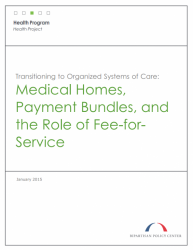You are looking at an archived version of our site. Please visit thepcc.org for a fresh, new experience!
You are here: Array » Transitioning to Organ ...
Transitioning to Organized Systems of Care: Medical Homes, Payment Bundles, and the Role of Fee-for-Service

In today’s health care system, fee-for-service (FFS) remains the dominant payment model for both public and private payers. Retrospective, individual payments for each office visit, procedure, and other health service can and often does result in higher utilization—leading to more, though not necessarily better, care. BPC’s leaders believe that providing incentives to move to organized systems of care will both improve quality and slow the rate of growth in health care cost, as well as improve accountability and facilitate the transition to population health.
BPC’s Health Project is focused on advancing models of care that improve quality and value; at the same time, changes to the underlying fee schedules are necessary. Indeed, FFS payment rates frequently serve as the basis for assessing utilization and cost by assigning a value to services delivered. As a result, the success or failure of alternative payment models (APMs) is based on whether the model improves quality and slows cost growth relative to FFS. BPC has previously identified that inefficiencies, misaligned incentives, and fragmented care delivery inherent in the current FFS payment system have ultimately undermined quality and increased costs. While many providers and payers have taken significant steps to move away from FFS, many other providers throughout the country have not, and in some areas APM adoption is especially low. In those areas, it is important to incentivize provider migration to organized systems of care while recognizing that some providers may ultimately remain in the FFS system, even if less financially attractive.
Indeed, the widespread transition to new models of care will be difficult without stronger incentives for providers to adopt them, such as the enactment of legislation to establish higher annual fee-schedule payment-rate updates for providers participating in APMs. As part of A Bipartisan Rx, BPC recommended congressional action to establish differential updates in payment to accelerate that transition across all provider groups, now reflected, at least for physician-fee-schedule providers, in the tri-committee physician payment reform legislation (fixing the Medicare Sustainable Growth Rate, or SGR). Higher Medicare reimbursement for APM participation, including patient-centered medical homes, bundled payments, and accountable care organizations (ACOs), relative to FFS, will accelerate the transition to new, organized systems of care. Incentives in Medicare will increase participation in APMs; however, broader delivery system reform will concurrently require broader alignment across payers. While many employers and private insurers have provided leadership in transitioning to organized systems of care, the success of these payment models will depend on broader private- and public-sector engagement. Without these changes, many providers will not have sufficient incentive to move away from FFS.
Full Resource/Source: Bipartisan Policy Center
Secondary menu
Copyright © 2024 Primary Care Collaborative



